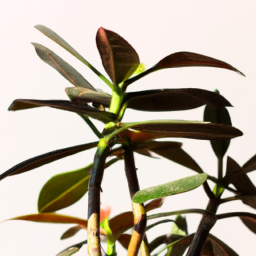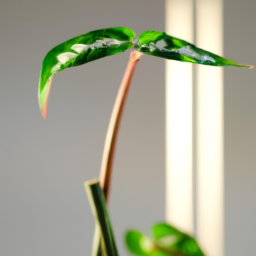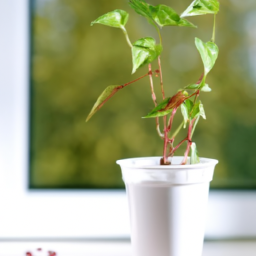
Have you ever wondered if indoor plants can thrive under artificial light? The answer is yes! Many indoor plants can actually grow quite well with the help of artificial light sources. Whether you’re looking to add some greenery to your home or office space, or you’re just curious about the science behind plant growth, this blog post will explore the question, “Can indoor plants grow in artificial light?” Let’s delve into the fascinating world of indoor gardening and discover how you can create a thriving indoor garden with the right lighting setup.
Benefits of Growing Indoor Plants Under Artificial Light
Introduction
When it comes to growing indoor plants, many people believe that natural sunlight is the only way to go. However, with advancements in technology, artificial light has become a viable option for providing the necessary light for plants to thrive indoors. In this article, we will explore the benefits of growing indoor plants under artificial light and how you can set up your own indoor garden using this method.
Increased Control Over Light Levels
One of the main benefits of using artificial light to grow indoor plants is the ability to control the light levels. Natural sunlight can be inconsistent, especially in areas with long winters or limited sunlight. With artificial light, you can tailor the amount and intensity of light your plants receive, ensuring they get the optimal conditions for growth.
In addition, artificial light allows you to provide light to plants that may not be in direct sunlight. This means you can grow plants in areas of your home that may not have access to natural light, such as basements or rooms with small windows. By using artificial light, you can create a thriving indoor garden no matter where you live.
Another advantage of using artificial light is the ability to extend the growing season. With natural sunlight, plants may go dormant during the winter months when daylight hours are shorter. By using artificial light, you can provide consistent light to your plants year-round, allowing them to continue growing and producing even in the darkest months.
Energy Efficiency and Cost Savings
While setting up an indoor garden with artificial light may require an initial investment in equipment, it can actually be more energy efficient and cost-effective in the long run. LED grow lights, in particular, are known for their energy efficiency and long lifespan, making them a sustainable option for indoor gardening.
In addition, artificial light allows you to customize the light spectrum to meet the specific needs of your plants. Different types of plants require different light wavelengths for optimal growth, and with artificial light, you can easily adjust the spectrum to ensure your plants are getting the right light for photosynthesis.
Furthermore, artificial light can be used in conjunction with natural sunlight to supplement the light your plants receive. This can be especially beneficial in areas with limited sunlight or during the winter months when natural light may be scarce. By using artificial light strategically, you can ensure your plants are getting the light they need to thrive.
In conclusion, growing indoor plants under artificial light offers a range of benefits, from increased control over light levels to energy efficiency and cost savings. By setting up an indoor garden with artificial light, you can create a thriving oasis in your home no matter the season or location. So why wait? Start your indoor garden today and watch your plants flourish under the glow of artificial light.

Can Indoor Plants Grow in Artificial Light
As an expert in indoor plant growth, I can confidently say that yes, indoor plants can indeed grow in artificial light. While natural sunlight is the best source of light for plants, artificial light can be a great alternative, especially for those who don’t have access to sufficient natural light in their living spaces. In order for indoor plants to thrive under artificial light, it’s important to understand the different types of artificial light available and how they can affect plant growth.
Types of Artificial Light
There are several types of artificial light that can be used to promote indoor plant growth. The most common types include incandescent, fluorescent, LED, and high-intensity discharge (HID) lights. Each type of light has its own pros and cons, and the best choice will depend on the specific needs of the plants being grown.
Incandescent lights are the least efficient option for indoor plant growth, as they produce a lot of heat and not as much light in the blue and red spectrum that plants need for photosynthesis. Fluorescent lights, on the other hand, are a more energy-efficient option and can be a good choice for growing a variety of plants. LED lights are becoming increasingly popular for indoor plant growth, as they are energy-efficient, long-lasting, and can be customized to provide the specific spectrum of light that plants need.
HID lights are the most intense option for indoor plant growth, providing a high level of light output that can promote fast and vigorous growth. However, they can also be more expensive and require more maintenance than other types of artificial light. When choosing the best type of artificial light for indoor plants, it’s important to consider factors such as the specific light requirements of the plants being grown, the energy efficiency of the light source, and the cost of installation and maintenance.
Choosing the Right Light Spectrum
One of the most important factors to consider when using artificial light for indoor plant growth is the light spectrum. Plants require different wavelengths of light for photosynthesis, with blue light being important for vegetative growth and red light being important for flowering and fruiting. In order to promote healthy growth and development, it’s important to provide plants with the right balance of blue and red light.
LED lights are a great option for providing the specific spectrum of light that plants need, as they can be customized to emit the right wavelengths for different stages of plant growth. When choosing LED lights for indoor plants, look for lights that provide a full spectrum of light, including both blue and red wavelengths. This will help ensure that plants receive the right balance of light for optimal growth and development.
It’s also important to consider the intensity of light when using artificial light for indoor plant growth. Different plants have different light requirements, so it’s important to provide plants with the right level of light intensity for their specific needs. In general, leafy green plants require less intense light than flowering plants, so it’s important to adjust the light intensity accordingly.
Optimizing Light Duration and Placement
In addition to choosing the right type of artificial light and providing the right spectrum and intensity of light, it’s also important to optimize the duration and placement of light for indoor plant growth. Most indoor plants require around 12-16 hours of light per day in order to thrive, so it’s important to provide plants with enough light to promote healthy growth and development.
When placing artificial light for indoor plants, it’s important to consider factors such as the distance between the light source and the plants, as well as the angle of the light. Placing lights too close to plants can cause heat stress and damage, while placing lights too far away can result in insufficient light levels. It’s important to experiment with different light placement and durations in order to find the optimal setup for your specific plants.
Overall, indoor plants can indeed grow in artificial light, as long as the right type of light is chosen, the right spectrum and intensity of light are provided, and the light duration and placement are optimized for plant growth. By following these guidelines, you can successfully grow a wide variety of plants indoors using artificial light.

Tips for Successfully Growing Indoor Plants with Artificial Light
Understanding the Basics
When it comes to growing indoor plants with artificial light, it is essential to understand the basics of plant growth and the role that light plays in this process. Plants require light to photosynthesize, which is the process by which they convert light energy into chemical energy to fuel their growth. In nature, plants receive sunlight, which provides them with the full spectrum of light they need to thrive. However, when growing plants indoors, artificial light sources must be used to mimic natural sunlight.
There are several factors to consider when choosing artificial light for indoor plants. The intensity of the light, the color spectrum it emits, and the duration of exposure all play a crucial role in the success of your indoor garden. Different plants have different light requirements, so it is essential to research the specific needs of the plants you are growing to ensure they receive the appropriate light.
When setting up your indoor garden with artificial light, it is important to position the light source at the correct distance from the plants. Too close, and the plants may burn from the intensity of the light; too far, and they may not receive enough light to thrive. Experiment with different distances to find the optimal placement for your plants.
Choosing the Right Light Source
There are several types of artificial light sources available for indoor plant growth, each with its advantages and disadvantages. The most common types of artificial light used for indoor plants are fluorescent, LED, and high-intensity discharge (HID) lights.
Fluorescent lights are a popular choice for indoor plant growth because they are energy-efficient and emit a broad spectrum of light that is suitable for most plants. LED lights are also energy-efficient and can be customized to emit specific wavelengths of light that are beneficial for plant growth. HID lights are the most intense artificial light source and are ideal for larger indoor gardens or plants that require high light intensity.
When choosing the right light source for your indoor plants, consider the specific needs of the plants you are growing, as well as the size of your indoor garden and your budget. It may be necessary to use a combination of different light sources to provide your plants with the optimal light they need to thrive.
Creating the Ideal Growing Environment
In addition to providing your indoor plants with the right light source, creating the ideal growing environment is essential for their success. Proper humidity levels, temperature control, and air circulation are all factors that can affect the health and growth of your plants.
Maintaining consistent humidity levels is crucial for indoor plant growth, as too much or too little humidity can lead to issues such as mold growth or plant dehydration. Investing in a hygrometer to monitor humidity levels in your indoor garden can help you ensure that your plants are receiving the right amount of moisture.
Temperature control is also important for indoor plant growth, as most plants thrive in temperatures between 65-75 degrees Fahrenheit. Avoid placing your plants near drafts or heating vents, as sudden temperature fluctuations can stress the plants and hinder their growth.
Lastly, proper air circulation is essential for indoor plant growth, as it helps prevent the buildup of mold and mildew on the plants. Consider using a fan to circulate air in your indoor garden and ensure that your plants have proper ventilation to thrive.
By following these tips and creating the ideal growing environment for your indoor plants with artificial light, you can enjoy a thriving indoor garden year-round. Remember to research the specific light requirements of the plants you are growing and adjust your lighting setup accordingly to ensure their success.
Key Takeaways
Many people believe that indoor plants need natural sunlight to thrive, but the truth is that they can actually grow quite well under artificial light. While natural sunlight is ideal for plants because it provides a full spectrum of light, artificial light can also be a suitable alternative. In fact, many indoor gardeners use artificial light to grow plants successfully in spaces where natural light is limited or non-existent.
When choosing artificial light for indoor plants, it’s important to consider the type of light and the amount of light the plants need. Different types of plants require different light intensities and durations, so it’s essential to match the right type of artificial light to the specific needs of your plants. LED grow lights are a popular choice for indoor plants because they are energy-efficient and can provide the full spectrum of light that plants need for photosynthesis. With the right setup and proper care, indoor plants can thrive and grow beautifully under artificial light. So, don’t let a lack of natural sunlight deter you from creating a lush indoor garden – artificial light can work wonders for your plants!
Let me leave you with some FAQs:
Q1: Can indoor plants grow in artificial light?
A1: Yes, indoor plants can grow in artificial light. As long as the artificial light provides the necessary spectrum of light that plants need for photosynthesis, they can thrive just as well as they would in natural sunlight.
Q2: What type of artificial light is best for indoor plants?
A2: The best type of artificial light for indoor plants is full-spectrum LED grow lights. These lights provide a balanced spectrum of light that closely mimics natural sunlight, promoting healthy growth and flowering in plants.
Q3: How long should indoor plants be exposed to artificial light each day?
A3: Indoor plants should be exposed to artificial light for about 12-16 hours each day. This mimics the long daylight hours of summer and ensures that plants receive enough light to photosynthesize and grow properly.
Q4: Can any indoor plant thrive solely on artificial light?
A4: While most indoor plants can thrive solely on artificial light, some high-light plants may require more intense light than what artificial sources can provide. It’s important to research the specific light requirements of the plant species you are growing.
Q5: Are there any tips for using artificial light to grow indoor plants successfully?
A5: To successfully grow indoor plants using artificial light, make sure to position the lights close enough to the plants without causing heat damage. Rotate the plants regularly to ensure even light exposure on all sides, and monitor the plants for any signs of light deficiency or excess.

James Wong is a renowned ethnobotanist, plant scientist, and local television presenter. With a passion for demystifying plant science, he is known for translating complex botanical concepts into practical advice for everyday plant enthusiasts. James’s expertise spans from traditional gardening to cutting-edge plant technologies, making his insights accessible and informative.


